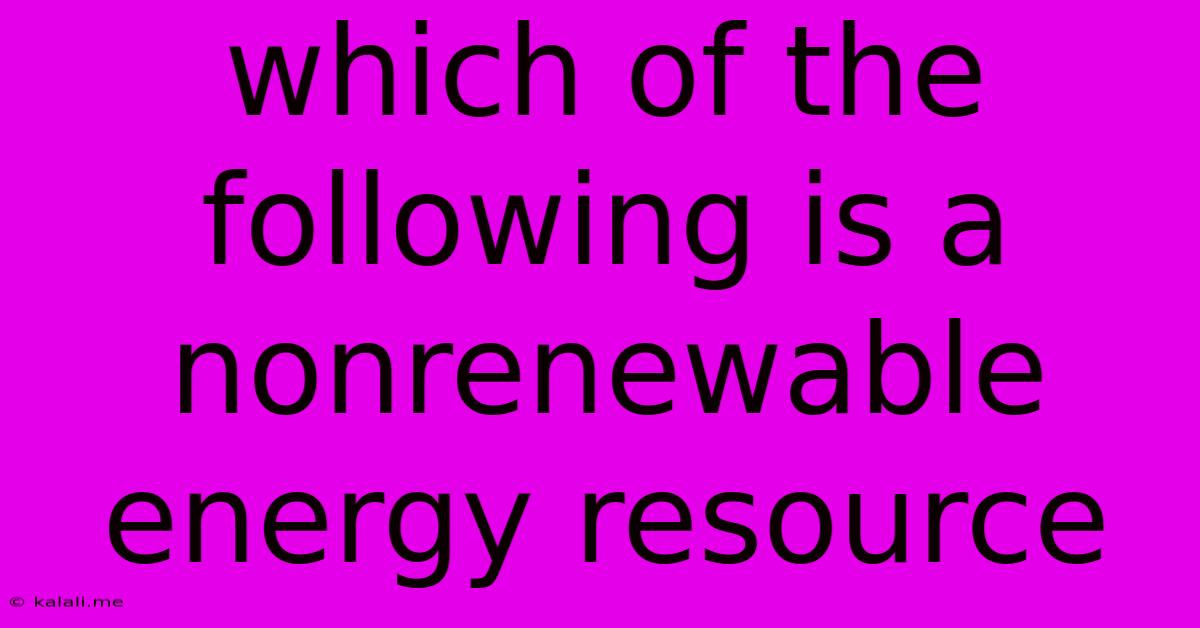Which Of The Following Is A Nonrenewable Energy Resource
Kalali
Jun 14, 2025 · 3 min read

Table of Contents
Which of the following is a nonrenewable energy resource? Understanding Finite Energy Sources
This article explores the concept of nonrenewable energy resources and helps you identify them from a given list. We'll delve into what makes a resource "nonrenewable" and provide clear examples to solidify your understanding. This knowledge is crucial for making informed decisions about energy consumption and advocating for sustainable practices.
What are Nonrenewable Energy Resources?
Nonrenewable energy resources are natural resources that are consumed at a much faster rate than they can be replenished. This means that once they're used up, they're essentially gone – at least on a human timescale. This finite nature poses significant environmental and economic challenges. Understanding the distinction between renewable and nonrenewable resources is key to addressing these challenges.
Key Characteristics of Nonrenewable Resources:
- Finite Supply: The most defining feature is their limited availability. Unlike renewable resources, they are not replenished naturally within a timeframe relevant to human use.
- Depletion: Continued use leads to their gradual depletion, potentially resulting in resource scarcity and price increases.
- Environmental Impact: The extraction, processing, and combustion of nonrenewable resources often contribute significantly to environmental pollution and climate change.
Examples of Nonrenewable Energy Resources:
Several types of energy resources fall under the nonrenewable category. The most prominent include:
-
Fossil Fuels: This encompasses coal, oil, and natural gas. These were formed from ancient organic matter over millions of years and are currently being consumed at an unsustainable rate. Burning fossil fuels releases greenhouse gases, contributing significantly to climate change. They are also associated with air and water pollution.
-
Nuclear Energy: While nuclear energy doesn't produce greenhouse gases in the same way as fossil fuels, it relies on uranium, a finite resource. Furthermore, the disposal of nuclear waste presents significant environmental and safety challenges. The risk of accidents at nuclear power plants also necessitates careful consideration.
Renewable Energy Resources (for comparison):
To fully understand nonrenewable resources, it's helpful to contrast them with their renewable counterparts. Renewable resources, such as solar, wind, hydro, geothermal, and biomass energy, are naturally replenished at a rate that surpasses human consumption. They are sustainable and have a much lower environmental impact.
Identifying Nonrenewable Resources in a List:
When presented with a list of energy resources, you can identify the nonrenewable ones by looking for the characteristics mentioned above: limited supply, depletion with use, and significant environmental impact during their lifecycle. For example, if a list contains solar, wind, coal, and natural gas, the nonrenewable resources would be coal and natural gas. Similarly, if a list includes geothermal, nuclear, and hydroelectric power, the nonrenewable resource would be nuclear.
Conclusion:
Understanding the difference between renewable and nonrenewable energy resources is crucial for navigating the challenges of energy production and consumption. Choosing sustainable practices and supporting the transition towards renewable energy sources is vital for ensuring a secure and healthy environment for future generations. By understanding the finite nature of nonrenewable resources like fossil fuels and nuclear energy, we can make informed decisions and contribute to a more sustainable energy future.
Latest Posts
Latest Posts
-
Ultimate Tensile Strength Of Cast Iron
Jun 14, 2025
-
What Is Scientific Name Of Snake
Jun 14, 2025
-
Ringers Solution Contains Which Of The Following
Jun 14, 2025
-
What Is The Prime Factorization Of 93
Jun 14, 2025
-
What Organelle Has Its Own Dna
Jun 14, 2025
Related Post
Thank you for visiting our website which covers about Which Of The Following Is A Nonrenewable Energy Resource . We hope the information provided has been useful to you. Feel free to contact us if you have any questions or need further assistance. See you next time and don't miss to bookmark.